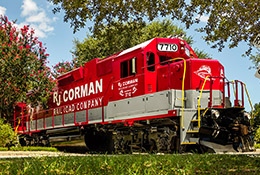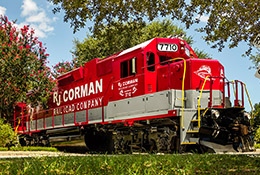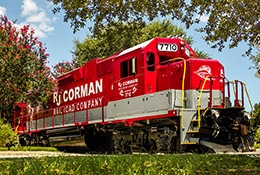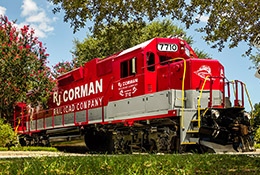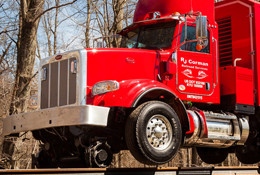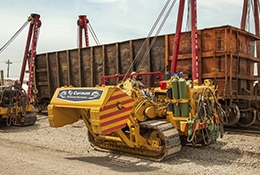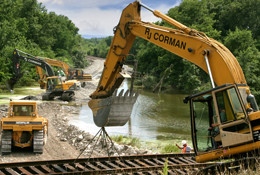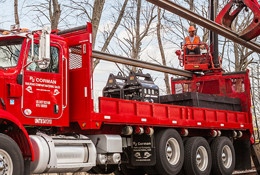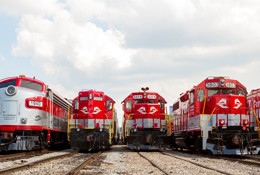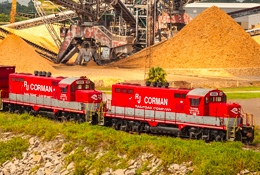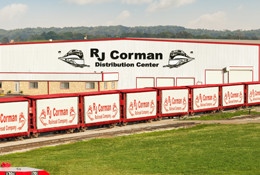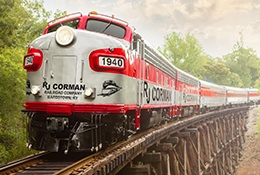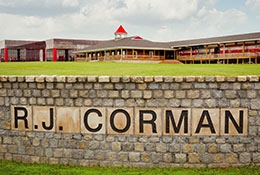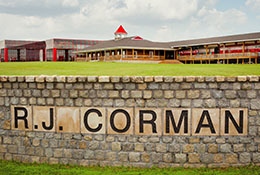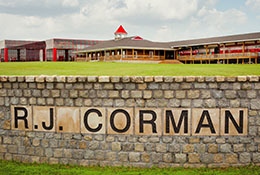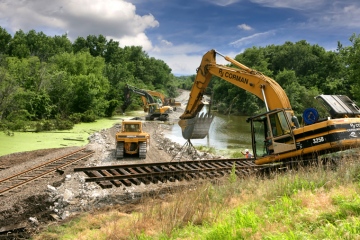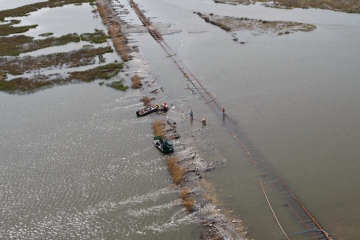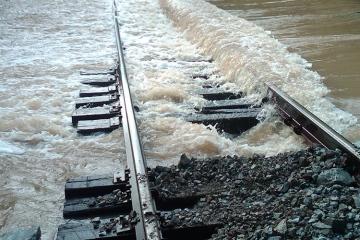November 12, 2005
R. J. Corman Storm Team: Massive Gulf Operation Gets Railroads Back on Track
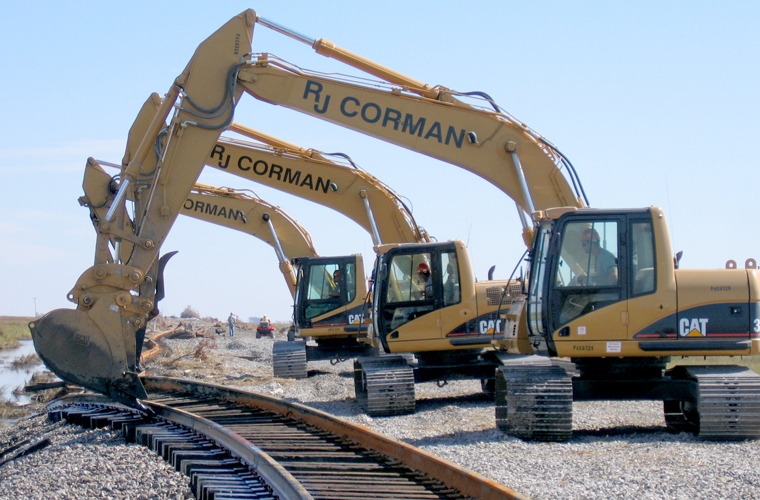
On August 29, 2005 at 6:10 a.m. Hurricane Katrina, a devastating Category 3 storm, slammed into the central Gulf Coast near Buras-Triumph, Louisiana. The 145 mile-per- hour winds and heavy rains created a storm surge that soon breached the levee system protecting New Orleans. In the end, Katrina left 90 percent of the once vibrant city of New Orleans submerged in water. In the days and hours before Katrina hit, most people along the coast prepared to save what they could of their lives. Many fled the coastline on evacuation orders, carrying with them some hope that in a few days they would find their homes still standing. Some stayed and waited for the storm’s destruction to unfold; many who stayed behind perished in the storm.
The railroad industry was hit hard by Hurricane Katrina. The storm destroyed or caused major damage to railroad infrastructure, including many bridges, from Florida to Louisiana. CSX Transportation, alone, had a 26-mile stretch of track that was almost completely destroyed within the 39-mile section east of New Orleans. Within those 26 miles, six major bridges were heavily damaged or destroyed. In addition, Hurricane Katrina left behind remnants of barges, houses and office buildings crisscrossing rail lines and lay scattered across Alabama, Mississippi, and Louisiana. Trees were stripped of leaves and blown across tracks. Locomotives and railcars were submerged in water and sidelined until the brake valves and wheel sets could be changed out.
The region’s and the nation’s economy depended on the quick return of business and industry to New Orleans. Since railroads account for more intercity freight traffic in the U.S. than any other mode of transportation, opening the tracks was vital to maintaining economic stability. This would be especially critical to the Gulf Coast due to its transportation of food products and oil. The rail corridors lining the Gulf Coast and the Port of New Orleans, had to be restored quickly due to the fact that they bring critical commodities and supplies to the country. Railroad companies like CSX Transportation, Norfolk Southern Corporation, and BNSF Railway planned ahead by calling on the R. J. Corman Storm Team to stage people and equipment for moving into action as soon as Katrina passed out of the area.
R. J. Corman’s Storm Team mobilized into several areas, including Mobile, Alabama, for the CSX engineering department and into Nicholson, Mississippi, for Norfolk Southern. What the Storm Team found was complete devastation described by many as “looking like a bomb had gone off.” Team members began reconstruction and rebuilding efforts in the area from Mobile towards Gulf Port, Mississippi. Crews used grapple trucks from R. J. Corman Material Sales Company, rotary dump trucks and track hoes from the Construction Company, plus chain saws and other heavy equipment to clear debris.
On September 1, 2005, CSX called upon R. J. Corman’s Storm Team to restore a double main line in Mobile clogged with ocean-going barges. R. J. Corman’s Jacksonville, Memphis, Atlanta and Shreveport Divisions were called in to complete the job. Together with a local tugboat company, the team needed to move 17, 450 ton barges, each valued at a half million dollars each. Using front-end loaders and side booms, the team pulled and repositioned the massive steel containers. The enormity of the barge job seemed a daunting task, but, in the end, the operation was successful and the tracks were cleared in 10 days.
The scope of work for the Gulf project was made up of eleven customers, including barge companies and industries. Although the primary customer was CSX, Storm Team crews from R. J. Corman’s Columbus and Nashville Divisions also performed engineering and mechanical work for Norfolk Southern Corporation that covered a route from Meridian, Mississippi, to Hattiesburg, Mississippi, to Slidell, Louisiana, and to New Orleans. Additional engineering work was called for by BNSF in Lafayette, Louisiana, and for the Union Pacific Railroad in Lake Charles, Louisiana. In Bay St. Louis, crews re-railed approximately 100 cars and repaired washouts for the Port Bienville Railroad.
The method by which the R. J. Corman crews approached the project was a spoke and wheel effect. The extent of the damage was widespread and extreme. Within two weeks, the railroads outside of New Orleans were back running. Unfortunately, CSX’s Gentilly Yard in New Orleans had suffered the worst blow. In Gentilly Yard, 700 cars were completely submerged. A three-mile stretch of R. J. Corman equipment convoyed its way to New Orleans to begin work. The task appeared formidable as the crews arrived to begin the project.
The widespread damage to the area required R. J. Corman to bring its own infrastructure in, which included a kitchen in a 53-foot box van that served as a food trailer. The company housed people in RVs, campers, trailers, and 21 tour buses because all the hotels were destroyed or closed down without utilities. R. J. Corman trucked in fresh water, both potable and nonpotable, for drinking water and showering. Essentially, R. J. Corman created its own city and provided everything needed for our crew to live during the extensive restoration project.
The different amenities inside R. J. Corman’s base camp of Gentilly Yard in New Orleans posed a security issue, which was handled CSX railroad police and the U.S. National Guard. A perimeter of portable light towers around the yard was in place because there was no electricity. There was a strict curfew that had to be abided by and nobody could be out after dark. Crews were also on alert for displaced wildlife that breached the work areas, such as: poisonous snakes and a large population of alligators.
Nine weeks after Katrina, the R. J. Corman Storm Team, which worked 12-hour days in two-weeks- on and one- week-off shift rotations, completed the work for all railroads and all projects with exception of the Gentilly Yard. The job continued on making the mechanical repairs necessary to get CSX’s railroad going in and out of New Orleans moving freely again.
This project was a collaborative effort of immense size and detail, carefully executed with pinpoint precision by several of R. J. Corman’s companies. The railroad industry chose R. J. Corman’s Storm Team time and time again for its ability to complete a job as quickly and safely as possible.

